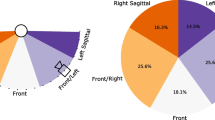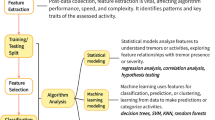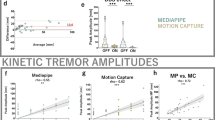Abstract
Background & purpose
Tremor is a common movement disorder diagnosed employing electrophysiological methods. Today, machine learning (ML) algorithms can efficiently analyze image-based data. Thus, we subjected the dynamics of essential tremor (ET) to video-based analysis.
Methods
We enrolled 59 ET patients and 48 age-matched normal controls. The Clinical Rating Scale for Tremor was used to score tremors. All subjects used a smartphone to record an image designed especially for this study while both stationary and in motion. The trajectories were divided into lower bandpass-filtered and bandpass-filtered (BPF) groups based on the frequency. We extracted seven trajectory features, including the angle, velocity, homogeneity, pitch, power, entropy, and cosine. We used Student’s t-test to compare the features of the ET patients and normal controls. A Random Forest model was employed to rank feature importance. Five ML models (random forest, k-nearest neighbors, support vector machine, decision tree, and multi-layer perceptron) were applied to estimate diagnostic accuracy.
Results
Significant differences in most of the features of the BPF signals were evident between the two groups. The velocity and homogeneity of the BPF trajectory were highest in the stationary and motion phases, respectively. The highest accuracy levels in the stationary, motion, and combined phases for predicting ET were 0.901, 0.757, and 0.892, respectively.
Conclusions
Features of ET tremor were evident in image-based data, enabling analysis of the tremor dynamics. ML analyses distinguished ET subjects from normal controls; however, more research is needed.






Similar content being viewed by others
Data Availability
The datasets used and/or analysed during the current study available from the corresponding author on reasonable request.
References
Deuschl G, Bain P, Brin M (1998) Consensus statement of the Movement Disorder Society on Tremor. Ad Hoc Scientific Committee Mov Disord 13(Suppl 3):2–23. https://doi.org/10.1002/mds.870131303
Spieker S, Boose A, Jentgens C, Dichgans J (1995) Long-term tremor recordings in parkinsonian and essential tremor. J Neural Transm Suppl 46:339–349
Deuschl G, Raethjen J, Lindemann M, Krack P (2001) The pathophysiology of tremor. Muscle Nerve 24:716–735. https://doi.org/10.1002/mus.1063
Bhatia KP, Bain P, Bajaj N, Elble RJ, Hallett M, Louis ED, Raethjen J, Stamelou M, Testa CM, Deuschl G et al (2018) Consensus Statement on the classification of tremors. from the task force on tremor of the International Parkinson and Movement Disorder Society. Mov Disord 33:75–87. https://doi.org/10.1002/mds.27121
Vial F, Kassavetis P, Merchant S, Haubenberger D, Hallett M (2019) How to do an electrophysiological study of tremor. Clin Neurophysiol Pract 4:134–142. https://doi.org/10.1016/j.cnp.2019.06.002
Chen KH, Lin PC, Chen YJ, Yang BS, Lin CH (2016) Development of method for quantifying essential tremor using a small optical device. J Neurosci Methods 266:78–83. https://doi.org/10.1016/j.jneumeth.2016.03.014
Mamorita N, Iizuka T, Takeuchi A, Shirataka M, Ikeda N (2009) Development of a system for measurement and analysis of tremor using a three-axis accelerometer. Methods Inf Med 48:589–594. https://doi.org/10.3414/ME9243
Murdoch TB, Detsky AS (2013) The inevitable application of big data to health care. JAMA 309:1351–1352. https://doi.org/10.1001/jama.2013.393
Müller AC, Guido S (2016) Introduction to Machine Learning with Python: A Guide for Data Scientists. O’Reilly Media, Inc
Biau G, Scornet E (2016) A random forest guided tour. TEST 25:197–227. https://doi.org/10.1007/s11749-016-0481-7
Domingos P (2012) A few useful things to know about machine learning. Commun ACM 55:78–87. https://doi.org/10.1145/2347736.2347755
Suthaharan S (2016) Support vector machine. In: Machine Learning Models and Algorithms for Big Data Classification. Integrated Series in Information Systems, vol 36. Springer, Boston, MA. https://doi.org/10.1007/978-1-4899-7641-3_9
Cortes C, Vapnik V (1995) Support-vector networks. Mach Learn 20:273–297. https://doi.org/10.1007/BF00994018
Kamiński B, Jakubczyk M, Szufel P (2018) A framework for sensitivity analysis of decision trees. Cent Eur J Oper Res 26:135–159. https://doi.org/10.1007/s10100-017-0479-6
Ramchoun H, Amine M, Idrissi J, Ghanou Y, Ettaouil M (2016) Multilayer perceptron: Architecture optimization and training. Int J Interact Multimed Artif Intell 4:26. https://doi.org/10.9781/ijimai.2016.415
Stacy MA, Elble RJ, Ondo WG, Wu SC, Hulihan J, TRS study group, (2007) Assessment of interrater and intrarater reliability of the Fahn-Tolosa-Marin Tremor Rating Scale in essential tremor. Mov Disord 22:833–838. https://doi.org/10.1002/mds.21412
Bhoi A (2019) Monocular Depth Estimation: A Survey. https://doi.org/10.48550/arXiv.1901.09402.
Duda RO, Hart PE, Stork DG (2000) Pattern classification, 2nd edn. Wiley-Interscience, New York. https://www.wiley.com
Hallett M (1998) Overview of human tremor physiology. Mov Disord 13(Suppl 3):43–48. https://doi.org/10.1002/mds.870131308
de Cheveigné A, Kawahara H (2002) YIN, a fundamental frequency estimator for speech and music. J Acoust Soc Am 111:1917–1930. https://doi.org/10.1121/1.1458024
Wang Y, Li J, Stoica P (2005) Spectral analysis of signals: The missing data case. Morgan and Claypool Publishers. https://doi.org/10.1007/978-3-031-02525-9
Acharya UR, Fujita H, Sudarshan VK, Bhat S, Koh JEW (2015) Application of entropies for automated diagnosis of epilepsy using EEG signals: A review. Knowl-Based Syst 88:85–96. https://doi.org/10.1016/j.knosys.2015.08.004
Breiman L (2001) Random Forests. Mach Learn 45:5–32. https://doi.org/10.1023/A:1010933404324
Pedregosa F, Varoquaux G, Gramfort A, Michel V, Thirion B, Grisel O, Blondel M, Prettenhofer P, Weiss R, Dubourg V, Vanderplas J, Passos A, Cournapeau D (2011) Scikit-learn: machine learning in python. J Mach Learn Res 12:2825–2830
Wong TT (2015) Performance evaluation of classification algorithms by k-fold and leave-one-out cross validation. Pattern Recognit 48:2839–2846. https://doi.org/10.1016/j.patcog.2015.03.009
Louis ED, Ottman R, Allen Hauser W (1998) How common is the most common adult movement disorder? Estimates of the prevalence of essential tremor throughout the world. Mov Disord 13:5–10. https://doi.org/10.1002/mds.870130105
Bain PG, Findley LJ, Atchison P, Behari M, Vidailhet M, Gresty M, Rothwell JC, Thompson PD, Marsden CD (1993) Assessing tremor severity. J Neurol Neurosurg Psychiatry 56:868–873. https://doi.org/10.1136/jnnp.56.8.868
Milanov I (2000) Clinical and electromyographic examinations of patients with essential tremor. Can J Neurol Sci 27:65–70. https://doi.org/10.1017/S0317167100052008
Milanov I (2001) Electromyographic differentiation of tremors. Clin Neurophysiol 112:1626–1632. https://doi.org/10.1016/s1388-2457(01)00629-0
Burkhard PR, Langston JW, Tetrud JW (2002) Voluntarily simulated tremor in normal subjects. Neurophysiol Clin 32:119–126. https://doi.org/10.1016/S0987-7053(02)00296-4
Gao JB (2004) Analysis of amplitude and frequency variations of essential and parkinsonian tremors. Med Biol Eng Comput 42:345–349. https://doi.org/10.1007/BF02344710
Salarian A, Russmann H, Wider C, Burkhard PR, Vingerhoets FJG, Aminian K (2007) Quantification of tremor and bradykinesia in Parkinson’s disease using a novel ambulatory monitoring system. IEEE Trans Biomed Eng 54:313–322. https://doi.org/10.1109/TBME.2006.886670
Breit S, Spieker S, Schulz JB, Gasser T (2008) Long-term EMG recordings differentiate between parkinsonian and essential tremor. J Neurol 255:103–111. https://doi.org/10.1007/s00415-008-0712-2
Giuffrida JP, Riley DE, Maddux BN, Heldman DA (2009) Clinically deployable Kinesia technology for automated tremor assessment. Mov Disord 24:723–730. https://doi.org/10.1002/mds.22445
Patel S, Lorincz K, Hughes R, Huggins N, Growdon J, Standaert D, Akay M, Dy J, Welsh M, Bonato P (2009) Monitoring motor fluctuations in patients with Parkinson’s disease using wearable sensors. IEEE Trans Inf Technol Biomed 13:864–873. https://doi.org/10.1109/TITB.2009.2033471
Kostikis N, Hristu-Varsakelis D, Arnaoutoglou M, Kotsavasiloglou C (2015) A smartphone-based tool for assessing parkinsonian hand tremor. IEEE J Biomed Health Inform 19:1835–1842. https://doi.org/10.1109/JBHI.2015.2471093
Ali SM, Arjunan SP, Peters J, Perju-Dumbrava L, Ding C, Eller M, Raghav S, Kempster P, Motin MA, Radcliffe PJ, Kumar DK (2022) Wearable sensors during drawing tasks to measure the severity of essential tremor. Sci Rep 12:5242. https://doi.org/10.1038/s41598-022-08922-6
Shahtalebi S, Atashzar SF, Patel RV, Jog MS, Mohammadi A (2021) A deep explainable artificial intelligent framework for neurological disorders discrimination. Sci Rep 11:9630. https://doi.org/10.1038/s41598-021-88919-9
Xing X, Luo N, Li S, Zhou L, Song C, Liu J (2022) Identification and classification of parkinsonian and essential tremors for diagnosis using machine learning algorithms. Front Neurosci 16:701632. https://doi.org/10.3389/fnins.2022.701632
De A, Bhatia KP, Volkmann J, Peach R, Schreglmann SR (2023) Machine learning in tremor analysis: Critique and directions. Mov Disord 38:717–731. https://doi.org/10.1002/mds.29376
Batra M, Agrawal R (2018) Comparative analysis of decision tree algorithms. In: Panigrahi BK, Hoda MN, Sharma V, Goel S, (eds.) Nature Inspired Computing. Singapore: Springer; 2018, p 31–6. (Advances in Intelligent Systems and Computing). https://doi.org/10.1007/978-981-10-6747-1_4
Hellwig B, Schelter B, Guschlbauer B, Timmer J, Lücking CH (2003) Dynamic synchronisation of central oscillators in essential tremor. Clin Neurophysiol 114:1462–1467. https://doi.org/10.1016/S1388-2457(03)00116-0
Raethjen J, Deuschl G (2012) The oscillating central network of Essential tremor. Clin Neurophysiol 123:61–64. https://doi.org/10.1016/j.clinph.2011.09.024
Acknowledgements
This study was supported by a 2021 research grant from Kangwon National University Hospital and Kangwon National University. The authors would like to thank Jeong Yun Song for performing data management.
Author information
Authors and Affiliations
Contributions
Conceptualization: Seung-Hwan Lee, Baeksop Kim.
Data curation: Seung-Hwan Lee.
Formal analysis: Seung-Hwan Lee, Baeksop Kim.
Investigation: Seung-Hwan Lee.
Methodology: Baeksop Kim.
Project administration: Seung-Hwan Lee, Jae-Min Shim, Baeksop Kim.
Resources: Seung-Hwan Lee, Baeksop Kim.
Software: Dongseop Lee, Jihoon Park, Jae-Min Shim, Baeksop Kim.
Supervision: Seung-Hwan Lee, Baeksop Kim.
Validation: Dongseop Lee, Jihoon Park, Jae-Min Shim, Baeksop Kim.
Writing – original draft: Seung-Hwan Lee.
Writing – review & editing: Seung-Hwan Lee, Baeksop Kim.
Corresponding authors
Ethics declarations
Ethical approval
This study was approved by the Institutional Review Board of Kangwon National University Hospital (KNUH-B-2021–02-005).
Conflict of interest
The authors declare that they have no conflicts of interest.
Additional information
Publisher's Note
Springer Nature remains neutral with regard to jurisdictional claims in published maps and institutional affiliations.
Rights and permissions
Springer Nature or its licensor (e.g. a society or other partner) holds exclusive rights to this article under a publishing agreement with the author(s) or other rightsholder(s); author self-archiving of the accepted manuscript version of this article is solely governed by the terms of such publishing agreement and applicable law.
About this article
Cite this article
Lee, SH., Lee, D., Park, J. et al. Quantification of tremor dynamics via video-based analysis. Multimed Tools Appl 83, 82963–82981 (2024). https://doi.org/10.1007/s11042-024-18438-y
Received:
Revised:
Accepted:
Published:
Issue Date:
DOI: https://doi.org/10.1007/s11042-024-18438-y




